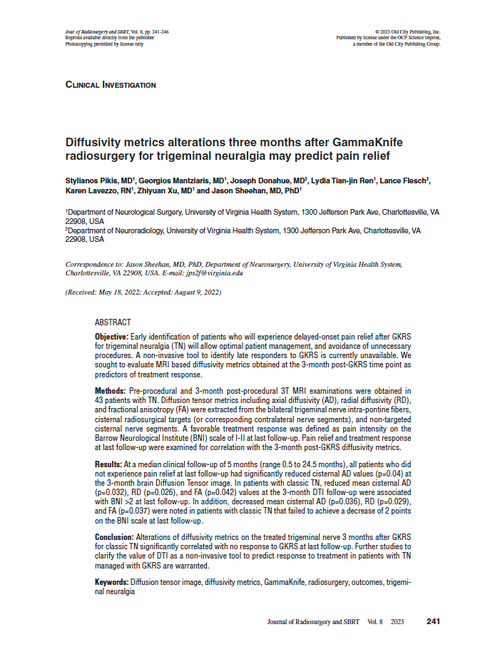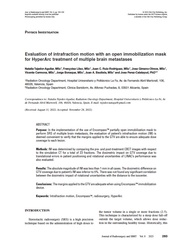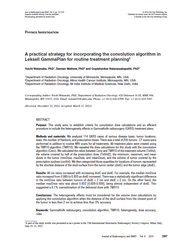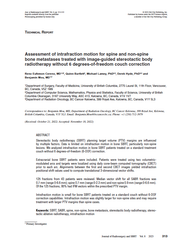- Home
- Journal Contents Downloads
- JRSBRT Downloads
- JRSBRT 8.4, p. 241-246
Product Description
Diffusivity metrics alterations three months after GammaKnife radiosurgery for trigeminal neuralgia may predict pain relief
Stylianos Pikis, Georgios Mantziaris, Joseph Donahue, Lydia Tian-Jin Ren, Lance Flesch, Karen Lavezzo, Zhiyuan Xu and Jason Sheehan
Objective: Early identification of patients who will experience delayed-onset pain relief after GKRS for trigeminal neuralgia (TN) will allow optimal patient management, and avoidance of unnecessary procedures. A non-invasive tool to identify late responders to GKRS is currently unavailable. We sought to evaluate MRI based diffusivity metrics obtained at the 3-month post-GKRS time point as predictors of treatment response.
Methods: Pre-procedural and 3-month post-procedural 3T MRI examinations were obtained in
43 patients with TN. Diffusion tensor metrics including axial diffusivity (AD), radial diffusivity (RD), and fractional anisotropy (FA) were extracted from the bilateral trigeminal nerve intra-pontine fibers, cisternal radiosurgical targets (or corresponding contralateral nerve segments), and non-targeted cisternal nerve segments. A favorable treatment response was defined as pain intensity on the Barrow Neurological Institute (BNI) scale of I-II at last follow-up. Pain relief and treatment response at last follow-up were examined for correlation with the 3-month post-GKRS diffusivity metrics.
Results: At a median clinical follow-up of 5 months (range 0.5 to 24.5 months), all patients who did not experience pain relief at last follow-up had significantly reduced cisternal AD values (p=0.04) at the 3-month brain Diffusion Tensor image. In patients with classic TN, reduced mean cisternal AD (p=0.032), RD (p=0.026), and FA (p=0.042) values at the 3-month DTI follow-up were associated with BNI >2 at last follow-up. In addition, decreased mean cisternal AD (p=0.036), RD (p=0.029), and FA (p=0.037) were noted in patients with classic TN that failed to achieve a decrease of 2 points on the BNI scale at last follow-up.
Conclusion: Alterations of diffusivity metrics on the treated trigeminal nerve 3 months after GKRS for classic TN significantly correlated with no response to GKRS at last follow-up. Further studies to clarify the value of DTI as a non-invasive tool to predict response to treatment in patients with TN managed with GKRS are warranted.
Keywords: Diffusion tensor image, diffusivity metrics, GammaKnife, radiosurgery, outcomes, trigeminal neuralgia
 Loading... Please wait...
Loading... Please wait...








